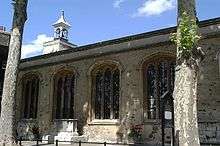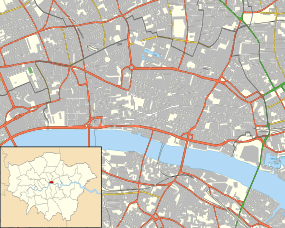Church of St Peter ad Vincula
| Church of St Peter ad Vincula | |
|---|---|
 Side of St. Peter chapel, viewed from near the place of execution on Tower Green | |
 Church of St Peter ad Vincula The church within the City of London | |
| 51°30′31″N 0°4′37″W / 51.50861°N 0.07694°WCoordinates: 51°30′31″N 0°4′37″W / 51.50861°N 0.07694°W | |
| Location | Tower Hamlets, London |
| Country | England |
| Denomination | Church of England |
| History | |
| Dedication | Saint Peter |
| Architecture | |
| Status | Active |
| Years built | 1519–20 |
| Administration | |
| Diocese | Royal Peculiar |
| Clergy | |
| Chaplain(s) | The Revd Canon Roger Hall |
- For other churches of this dedication, see St Peter ad Vincula (disambiguation).
The Chapel Royal of St. Peter ad Vincula ("St. Peter in chains") is the parish church of the Tower of London. It is situated within the Tower's Inner Ward and dates from 1520. It is a Royal Peculiar. The name refers to St. Peter's imprisonment under Herod Agrippa in Jerusalem. The Chapel is probably best known as the burial place of some of the most famous prisoners executed at the Tower, including Anne Boleyn, Catherine Howard, Lady Jane Grey, Thomas Cromwell, Thomas More and John Fisher.
At the west end is a short tower, surmounted by a lantern bell-cote, and inside the church is a nave and shorter north aisle, lit by windows with cusped lights but no tracery, a typical Tudor design.
The church is a Chapel Royal, and the priest responsible for it is the chaplain of the Tower, a canon and member of the Ecclesiastical Household. The canonry was abolished in 1685 but reinstated in 2012.
History
The existing building was rebuilt for Henry VIII by Sir Richard Cholmondeley in 1519–20, but a chapel stood in its position since before the Norman conquest.[1]
Parish of the Tower of London
St Peter ad Vincula was the church of the extra-parochial area of Tower Within, part of the Liberties of the Tower of London.[2] On 16 December 1729 the church was added to the Bills of mortality, a record of burials in London, but was excluded in 1730 because of a successful claim by the inhabitants of it being extra-parochial and outside of the normal parish system.[3] Extra-parochial places were eliminated in the 19th century, and in 1858 the area became a civil parish, following the Extra-Parochial Places Act 1857.[4] The Tower of London liberty was dissolved in 1894,[5] and the parish was absorbed by St Botolph without Aldgate in 1901.[4]
Burials and monuments
The church contains many splendid monuments. In the north-west corner is a memorial to John Holland, Duke of Exeter, a Constable of the Tower who died in 1447. Under the central arcade lies the effigy of Sir Richard Cholmondeley, a Lieutenant of the Tower who died in 1521.[1] In the sanctuary, there is an impressive monument to Sir Richard Blount, who died in 1564 and is buried in the church, and his son Sir Michael, died in 1610, both Tudor Lieutenants of the Tower, who would have witnessed many of the executions.[6] There is a fine 17th-century organ, decorated with carvings by Grinling Gibbons.
The church is perhaps most notable as the burial place of some of the most famous Tower prisoners, including three queens: Anne Boleyn and Catherine Howard, the second and fifth wives of Henry VIII, respectively, and Lady Jane Grey, who reigned for nine days in 1553. George Boleyn, brother of Anne, was also buried here after his execution in 1536, as were Edmund Dudley and Sir Richard Empson, tax collectors for Henry VII, and Guildford Dudley, husband to Lady Jane Grey, in February 1554, after being executed on Tower Green. Others were Thomas More and John Fisher, who incurred the wrath of Henry VIII, and after their execution, they were canonised as martyrs by the Roman Catholic Church; Philip Howard, a third saint who suffered under the Tudors, was also buried here for a time before his body was relocated to Arundel.[1] After their executions, the following people were also buried here: Henry VIII's minister, Thomas Cromwell (1540);[7] Edward Seymour, 1st Duke of Somerset (1552); John Dudley, 1st Duke of Northumberland and John Gates in connection with the 1553 succession crisis (1553); and James Scott, 1st Duke of Monmouth, under the communion table (1685).[8]
A list of 'remarkable persons' buried in the chapel between 1534 and 1747 is listed on a table on the west wall.[1] Thomas Babington Macaulay memorialised those buried in the chapel in his 1848 History of England: "In truth there is no sadder spot on the earth than that little cemetery. Death is there associated, not, as in Westminster Abbey and Saint Paul's, with genius and virtue, with public veneration and with imperishable renown; not, as in our humblest churches and churchyards, with everything that is most endearing in social and domestic charities; but with whatever is darkest in human nature and in human destiny, with the savage triumph of implacable enemies, with the inconstancy, the ingratitude, the cowardice of friends, with all the miseries of fallen greatness and of blighted fame. Thither have been carried, through successive ages, by the rude hands of gaolers, without one mourner following, the bleeding relics of men who had been the captains of armies, the leaders of parties, the oracles of senates, and the ornaments of courts."[9]
Chapel Royal
The church is a Chapel Royal and the priest responsible for it is the chaplain of the Tower of London, a canon and member of the Ecclesiastical Household. The canonry was abolished in 1685 but reinstated in 2012. The Reverend Roger Hall, MBE was installed as a canon the same year.[10]
The chapel can be visited as part of a specific tour within the Tower of London.
References
- 1 2 3 4 "Chapel of St Peter Ad Vincula", Camelot International: The Tower of London (2007)
- ↑ Burn, Richard; John Burn (1793). The Justice of the Peace, and Parish Officer, Volume 1.
- ↑ Miller, A. (1759). Collection of Yearly Bills of Mortality, from 1657 to 1758 Inclusive.
- 1 2 Youngs, Frederic A, Jr. (1979). Guide to the Local Administrative Units of England, Vol. I: Southern England. London: Royal Historical Society. pp. 556–707. ISBN 0-901050-67-9.
- ↑ "Tower of London", Star, Issue 5033, 20 August 1894, p. 3
- ↑ "St Peter ad Vincula, Tower of London, Tower Hill, London EC3: tourist information", TourUK, accessed 7 February 2013
- ↑ Bell, Doyne Courtenay. Thomas Cromwell, Earl of Essex, Notices of the historic persons buried in the chapel of St. Peter ad Vincula, J. Murray (1877), p. 109
- ↑ "James Scott, Duke of Monmouth", Family Search, accessed 12 June 2014
- ↑ Macaulay, Thomas Babington. The History of England from the Accession of James II, 5 vols. (1848)
- ↑ "Reverend Roger Hall becomes Tower's first Canon for 300 years", Historic Royal Palaces, accessed 21 February 2014